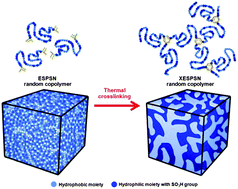Morphological transformation during cross-linking of a highly sulfonated poly(phenylene sulfide nitrile) random copolymer†
Abstract
We present a new approach of morphological transformation for effective

* Corresponding authors
a
School of Chemical Engineering, College of Engineering Hanyang University, Seoul 133-791, Republic of Korea
E-mail:
ymlee@hanyang.ac.kr
b WCU Department of Energy Engineering, Hanyang University, Seoul 133-791, Republic of Korea
c National Research Council, Ottawa, Ont, Canada
d Department of Green Energy Engineering, College of Engineering, Uiduk University, Gyeongju 780-713, Republic of Korea
e The 6th Research Team, Daedeok Research Institute, Honam Petrochemical Corp., Daejeon 305-726, Republic of Korea
We present a new approach of morphological transformation for effective

 Please wait while we load your content...
Something went wrong. Try again?
Please wait while we load your content...
Something went wrong. Try again?
S. Y. Lee, N. R. Kang, D. W. Shin, C. H. Lee, K. Lee, M. D. Guiver, N. Li and Y. M. Lee, Energy Environ. Sci., 2012, 5, 9795 DOI: 10.1039/C2EE21992A
To request permission to reproduce material from this article, please go to the Copyright Clearance Center request page.
If you are an author contributing to an RSC publication, you do not need to request permission provided correct acknowledgement is given.
If you are the author of this article, you do not need to request permission to reproduce figures and diagrams provided correct acknowledgement is given. If you want to reproduce the whole article in a third-party publication (excluding your thesis/dissertation for which permission is not required) please go to the Copyright Clearance Center request page.
Read more about how to correctly acknowledge RSC content.
 Fetching data from CrossRef.
Fetching data from CrossRef.
This may take some time to load.
Loading related content
